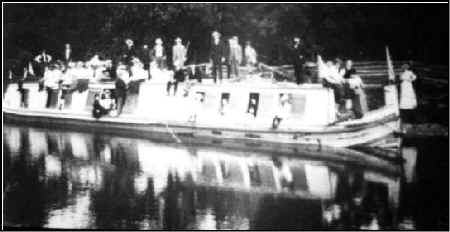|
Passenger Traffic
Although a majority of the canal boats hauled
cargo, there was a significant amount of passenger traffic as well. The so-called 'express
packets,' constructed of lighter materials, could average as much as six to eight miles an
hour. These boats were 78 feet long and 15 feet wide, with separate compartments for
passengers, crew, and mules. Carrying up to 50 people, an express packet could complete
the long journey from Cincinnati to Toledo in 5 days and 4 nights. Captains of these
crafts usually demanded the right of way over other boats along the canal, and especially
at the locks. This resulted in occasional fights between boat captains, which the lock
tender would usually referee.
Lawn chairs would be placed on the deck in good weather.
Passengers so inclined had to be alert, for a shout of "low bridge!"
would send them ducking for cover. Although the fares varied by locality, a rule of thumb
was that long trips cost four cents a mile. Meals and board were included, as were 30
pounds of baggage. Passenger packets also served as excursion craft on the weekends.
Loaded down with partiers and supplies, these boats would proceed at a leisurely pace, or
stop, so that those on board could fish or picnic on the banks of the canal. Lockington was a favorite destination, as the men on board could visit a saloon or two while the boat
waited to pass through the locks. This activity was also popular for company outings.
School children apparently enjoyed periodic excursions on the canal as well. The May 7,
1852, edition of the "Shelby County Democrat" carried the following news
item: "N. R. Wyman (a teacher) is out today with his school in a Maying excursion.
They took passage on the canal boat 'Clarion.' Nathan called to his aid a number of
young ladies and gentlemen of the place to assist him in discharging his duties. We wish
them a pleasant time."

'Canal' segment written in
December, 1998 by Rich Wallace
[ Back to Canal Index ]
|

